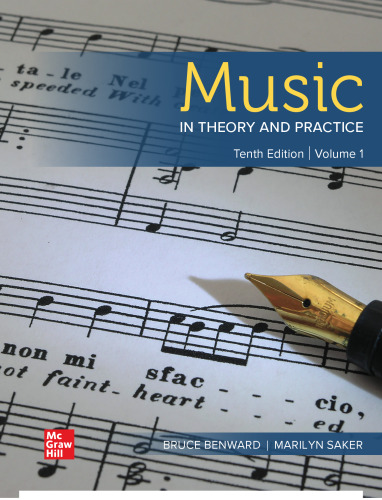Description
Music in Theory and Practice Volume One 10th Edition by Bruce Benward, ISBN-13: 978-1260055825
[PDF eBook eTextbook] – Available Instantly
- Publisher: McGraw Hill; 10th edition (January 27, 2020)
- Language: English
- 432 pages
- ISBN-10: 1260055825
- ISBN-13: 978-1260055825
This best-selling program gives music majors and minors a solid foundation in the theory of music. Music in Theory and Practice 10e strengthens musical intuition, builds technical skills, and helps gain interpretive insights. The goal of the content is to instruct readers on the practical application of knowledge. The analytical techniques presented are carefully designed to be clear, uncomplicated, and readily applicable to any repertoire.
The two-volume format ensures exhaustive coverage and maximum support for students and faculty alike. Volume I serves as a general introduction to music theory while Volume II offers a survey of the theoretical underpinnings of musical styles and forms from Gregorian Chant through the present day. The supplemental instructor’s materials provide clear-cut solutions to assignment materials. Music in Theory and Practice is a well-rounded program that integrates the various components of musical structure and makes them accessible to students at the undergraduate level.
Table of Contents:
Cover Page
Preface ix
Introduction The Materials of Music: Sound and Time xiii
Sound xiii
Vibration xiii
Compression and Rarefaction xiii
Frequency xiv
The Four Properties of Sound xiv
Pitch xiv
Intensity xiv
Duration xiv
Timbre xv
Summary xvi
PART A
The Fundamentals of Music 1
CHAPTER 1
Notation 3
Important Concepts 3
Notation of Pitch 3
The Staff 3
Letter Names 3
The Clefs 4
Octave Identification 6
Accidentals 7
Interval 7
Enharmonic Equivalents 8
Half-Step Motion 8
Notation of Duration 8
The Tie 9
The Dot 9
Irregular Division of Notes 10
Rhythm 10
Meter Signatures 10
Dynamic Markings 15
Tempo 15
History 15
Applications 17
Some Directions for Notation 17
Summary 22
Practice 22
Assignments 23
CHAPTER 2
Scales, Tonality, Key, Modes 29
Important Concepts 29
Scale 29
Pitch Class 29
Diatonic Scales 30
Scale Degree Names 30
Major Scale 31
Tetrachord 31
Transposition 32
Key Signature 32
Minor Scale 34
Scale Relationships 38
Tonality 41
Key 41
Other Scales 42
History 46
Applications 48
Pitch Inventory 49
Summary 49
Practice 50
Assignments 51
CHAPTER 3
Intervals and Transposition 57
Important Concepts 57
Intervals 57
Perfect, Major, and Minor Intervals 58
Consonance and Dissonance 60
Augmented and Diminished Intervals 60
Enharmonic Intervals 61
Inversion of Intervals 61
Compound Intervals and Simple Intervals 63
History 63
Applications 64
Fluency with Intervals 64
Melodic and Harmonic Intervals 65
Transposition 66
Methods of Transposition 66
Practice 68
Assignments 69
CHAPTER 4
Chords 77
Important Concepts 77
Harmony 77
Chord 77
Triad 77
Triad Root 77
Major Triad 78
Minor Triad 78
Diminished Triad 78
Augmented Triad 78
Triad Stability 79
Triad Names 79
Primary Triads 79
Triad Position 79
Root Position 79
Triad Inversion 80
First Inversion 80
Second Inversion 80
Other Tertian Chords 81
Seventh Chords 81
History 81
Applications 81
Roman Numeral Analysis 82
Triad Position Symbols 83
Seventh-Chord Position Symbols 84
Figured Bass 84
Figured-Bass Symbols 85
Macro Analysis 87
Popular-Music Symbols 89
Summary 90
Practice 90
Assignments 91
PART B
The Structural Elements of Music 99
CHAPTER 5
Cadences and Nonharmonic Tones 101
Important Concepts 101
Phrase 101
Harmonic Cadence 101
Rhythmic Cadence 103
History 104
Nonharmonic Tones 106
Unaccented Nonharmonic Tones 107
Accented Nonharmonic Tones 108
Accented versus Unaccented Nonharmonic Tones 113
Nonharmonic Tones Involving More Than Three Pitches 113
Summary of Nonharmonic Tones 115
Practice 115
Assignments 117
CHAPTER 6
Melodic Organization 123
Important Concepts 123
The Motive 123
Sequence 125
Phrase 127
Period 129
Modification of the Phrase 133
Melodic Structure 135
History 137
Practice 138
Assignments 139
CHAPTER 7
Texture and Textural Reduction 149
Important Concepts 149
Texture 149
Texture Types 151
History 154
Applications 155
Analysis of Texture 155
Textural Reduction 159
Practice 160
Assignments 161
CHAPTER 8
Species Counterpoint 167
Important Concepts 167
Species Counterpoint 167
The Cantus Firmus 167
The Counterpoint 167
First Species Counterpoint 167
Second Species Counterpoint 168
Third Species Counterpoint 168
Fourth Species Counterpoint 168
Fifth Species Counterpoint 169
History 169
Applications 170
Modal Scales 170
Melodic Characteristics 171
Writing First Species Counterpoint 172
Writing Second Species Counterpoint 176
Writing Third Species Counterpoint 179
Writing Fourth Species Counterpoint 182
Writing Fifth Species Counterpoint 184
Summary 186
Practice 186
Assignments 187
CHAPTER 9
Voice Leading in Four-Part Chorale Writing 195
Important Concepts 195
Four-Voice Texture 195
History 196
Applications 196
Analysis of the Chorale Phrases 198
Stylistic Practices 198
Root-Position Triads 198
Repeated Chords 202
First-Inversion Triads 202
Second-Inversion Triads 204
Exceptions to Stylistic Practices 206
Unstylistic Departures 206
Voice Ranges 207
Voice Spacing 207
Summary 208
Practice 208
Assignments 209
CHAPTER 10
Harmonic Progression and Harmonic Rhythm 217
Important Concepts 217
Harmonic Progression 217
The Relationship of Chords 218
Chord Progressions 218
Harmonic Rhythm 223
History 224
Applications 226
How to Harmonize a Tonal Melody 226
Practice 228
Assignments 229
CHAPTER 11
The Dominant Seventh Chord 239
Important Concepts 239
Dominant Seventh Chord 239
Macro Analysis Symbol 241
History 241
Applications 243
Resolution of the Dominant Seventh Chord 243
Circle Progression 243
Noncircle Progressions with Resolution 245
Nonresolution of Seventh Factor 245
Stylistic Practices for Voice Leading in V7 Chords 246
Practice 246
Assignments 247
CHAPTER 12
The Leading-Tone Seventh Chords 259
Important Concepts 259
Leading-Tone Seventh Chords 259
Progressions from viiø7 and vii°7 260
Resolution of Tritone and Seventh Factors 261
Macro Analysis Symbols 262
History 262
Applications 265
Voice Leading and the viiø7 and vii°7 265
Some Pitfalls to Avoid 265
Practice 266
Assignments 267
CHAPTER 13
Nondominant Seventh Chords 275
Important Concepts 275
Nondominant Seventh Chords 275
Roman Numeral Symbols 275
Seventh Chords in Major and Minor Keys 276
Macro Analysis Symbols 277
History 278
Applications 280
Nondominant Seventh Chords in Circle Progressions 280
Resolution of the Seventh Factor 280
Noncircle Treatment 281
Voice Leading of Nondominant Seventh Chords 282
Practice 282
Assignments 283
CHAPTER 14
Secondary Dominant and Leading-Tone Chords 291
Important Concepts 291
Secondary Dominants 291
Secondary Leading-Tone Chords 294
Macro Analysis 297
History 299
Summary 305
Practice 305
Assignments 307
CHAPTER 15
Modulation 319
Important Concepts 319
Modulation 319
Closely Related Keys 319
Common-Chord Modulation 320
Chromatic Modulation 320
Phrase Modulation 321
Other Modulation Types 321
Modulations in Period Construction 322
Analytical Symbols for Modulations 323
Macro Analysis 324
History 325
Applications 325
Harmonizing Melodies That Modulate 325
Practice 328
Assignments 329
CHAPTER 16
Two-Part (Binary) Form 343
Important Concepts 343
Formal Divisions 343
Open versus Closed Formal Divisions 343
Simple versus Compound Forms 343
Two-Part Form 343
History 350
Summary 351
Practice 351
Assignments 353
CHAPTER 17
Three-Part (Ternary) Form 359
Important Concepts 359
Three-Part Form 359
Expanded Ternary Form 364
Rounded Binary Form 364
History 366
Summary 367
Practice 368
Assignments 369
Appendixes
A. Summary of Part-Writing Practices 377
B. Macro Analysis Symbols 379
C. Popular Music Chord Symbols 381
D. Expression Marks 383
E. Instrument Ranges, Transpositions, and Foreign Names 385
F. History 389
Glossary 393
Credits 399
Indexes
Musical Example Index 401
Subject Index 405
Bruce Benward has been widely regarded as one of the most gifted music theory pedagogues since his textbooks first appeared in the 1960s, and has exerted a wide influence on the teaching of music theory both through his writings and through the generation of teachers that he taught. He recently retired from the University of Wisconsin at Madison.
What makes us different?
• Instant Download
• Always Competitive Pricing
• 100% Privacy
• FREE Sample Available
• 24-7 LIVE Customer Support






